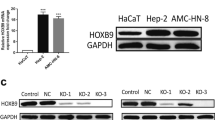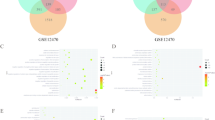Abstract
Purpose
The Jun proteins (c-Jun, JunD and JunB) play an important role in the regulation of cell proliferation, apoptosis and angiogenesis. It is well established that these proteins participate in the carcinogenesis and progression in several tumour types. However, little is known about the prognostic significance of Jun proteins in patients with invasive epithelial ovarian carcinoma.
Methods
We analysed fresh-frozen tissues of 161 ovarian cancer patients by using Western blot analysis to investigate protein levels of JunB, JunD, c-Jun and phosphorylated c-Jun (pc-Jun Ser63). The results were correlated with clinicopathologic prognostic parameters and survival data.
Results
A high pc-Jun expression was significantly associated with shorter progression-free survival (14 vs. 16 months, p = 0.017) and overall survival (25 vs. 41 months, p = 0.038). In case of JunD, moderate protein levels were associated with a better prognosis, leading to longer progression-free and overall survival compared to weak or strong JunD expression (PFS in cases with weak/moderate/strong JunD expression: 14 vs. 19.5 vs. 16 months, p = 0.011; OAS: 32 vs. 42 vs. 35.5 months, p = 0.009). Multivariate Cox regression analysis confirmed an independent and significant impact of pc-Jun and JunD on the patient’s prognosis.
Conclusions
Our results show that Jun proteins (pc-Jun and JunD) influence carcinogenesis and tumour progression, suggesting a significant role as prognostic predictors in human ovarian carcinoma.





Similar content being viewed by others
References
Agarwal SK, Novotny EA, Crabtree JS et al (2003) Transcription factor JunD, deprived of menin, switches from growth suppressor to growth promoter. Proc Natl Acad Sci USA 100:10770–10775
Angel P, Karin M (1991) The role of Jun, Fos and the AP-1 complex in cell-proliferation and transformation. Biochim Biophys Acta 1072:129–157
Behrens A, Sibilia M, Wagner EF (1999) Amino-terminal phosphorylation of c-Jun regulates stress-induced apoptosis and cellular proliferation. Nat Genet 21:326–329
Chinenov Y, Kerppola TK (2001) Close encounters of many kinds: Fos–Jun interactions that mediate transcription regulatory specificity. Oncogene 2:2438–2452
Davis RJ (2000) Signal transduction by the JNK group of MAP kinases. Cell 103:239–252
Dérijard B, Hibi M, Wu I-H, Barrett T, Su B, Deng T, Karin M, Davis RJ (1994) JNK1: a protein kinase stimulated by UV light and Ha-Ras that binds and phosphorylates the c-Jun activation domain. Cell 76:1025–1037
Du Bois A, Quinn M, Thigpen T et al (2004) 2004 consensus statements on the management of ovarian cancer: final document of the 3rd International Gynecologic Cancer Intergroup Ovarian Cancer Consensus Conference (GCIG OCCC 2004). Ann Oncol 16(Suppl 8):viii7–viii12
Ferlay J, Steliarova-Foucher E, Lortet-Tieulent J, Rosso S, Coebergh JW, Comber H, Forman D, Bray F (2013) Cancer incidence and mortality patterns in Europe: estimates for 40 countries in 2012. Eur J Cancer 49(6):1374–1403
Gerald D, Berra E, Frapart YM (2004) JunD reduces tumor angiogenesis by protecting cells from oxidative stress. Cell 118:781–794
Hein S, Mahner S, Kanowski C, Löning T, Jänicke F, Milde-Langosch K (2009) Expression of Jun and Fos proteins in ovarian tumours of different malignant potential and in ovarian cancer cell lines. Oncol Rep 22:177–183
Jochum W, Passegue E, Wagner EF (2001) AP-1 in mouse development and tumorigenesis. Oncogene 20:2401–2412
Johnson RS, van Lingen B, Papaioannou VE, Spiegelman BM (1993) A null mutation at the c-jun locus causes embryonic lethality and retarded cell growth in culture. Genes Dev 7:1309–1317
Karin M (1995) The regulation of AP-1-activity by mitogen-activated protein kinases. J Biol Chem 270(28):16483–16486
Kimura R, Ishikawa C, Rokkaku T, Janknecht R, Mori N (2011) Phosphorylated c-Jun and Fra-1 induce matrix metalloproteinase-1 and thereby regulate invasion activity of 143B osteosarcoma cells. Biochim Biophys Acta 1813(8):1543–1553
Le-Niculescu H, Bonfoco E, Kasuya Y, Claret F-X, Green DR, Karin M (1999) Withdrawal of survival factors results in activation of the JNK pathway in neuronal cells leading to Fas ligand induction and cell death. Mol Cell Biol 19:751–763
Mahner S, Baasch C, Schwarz J, Hein S, Wölber L, Jänicke F, Milde-Langosch K (2008) C-Fos expression is a molecular predictor of progression and survival in epithelial ovarian carcinoma. Br J Cancer 99:1269–1275
Mathas S, Hinz M, Anagnostopoulos I, Krappmann D, Lietz AQ, Jundt F, Bommert K, Mechta-Grigoriou F, Stein H, Dörken B, Scheidereit C (2002) Aberrantly expressed c-Jun and JunB are a hallmark of Hodgkin lymphoma cells, stimulate proliferation and synergize with NF-kappa B. EMBO J 21(15):4104–4113
Milde-Langosch K (2005) The Fos family of transcription factors and their role in tumourigenesis. Eur J Cancer 41(16):2449–2461
Milde-Langosch K, Janke S, Wagner I, Schröder C, Streichert T, Bamberger A-M, Jänicke F, Löning T (2008) Role of Fra-2 in breast cancer: influence on tumor cell invasion and motility. Breast Cancer Res Treat 107(3):337–347
Pfarr CM, Mechta F, Spyrou G, Lallemand D, Carillo S, Yaniv M (1994) Mouse JunD negatively regulates fibroblast growth and antagonizes transformation by ras. Cell 76:747–760
Pulverer BJ, Kyriakis JM, Avruch J, Nikolakaki E, Woodgett JR (1991) Phosphorylation of c-jun mediated by MAP kinases. Nature 353(6345):670–674
Shaulian E (2010) AP-1—the Jun proteins: oncogenes or tumor suppressor in disguise? Cell Signal 22:894–899
Toft DJ, Rosenberg SB, Bergers G, Volpert O, Linzer DIH (2001) Reactivation of proliferin gene expression is associated with increased angiogenesis in a cell culture model of fibrosarcoma tumor progression. Proc Natl Acad Sci USA 98:13055–13059
Vivas-Mejia P, Benito JM, Fernandez A et al (2010) c-Jun-NH2-kinase-1 inhibition leads to antitumor activity in ovarian cancer. Clin Cancer Res 16:184–194
Weiss C, Schneider S, Wagner EF, Zhang X, Seto E, Bohmann D (2003) JNK phosphorylation relieves HDAC3-dependent suppression of the transcriptional activity of c-Jun. EMBO J 22:3686–3695
Weitzman JB, Fiette L, Matsuo K, Yaniv M (2000) JunD protects cells from p53-dependent senescence and apoptosis. Mol Cell 6:1109–1119
Wisdom R, Johnson RS, Moore C (1999) c-Jun regulates cell cycle progression and apoptosis by distinct mechanisms. EMBO J 18:188–197
Zhou H, Gao J, Lu ZY, Lu L, Dai B, Xu M (2007) Role of c-Fos/JunD in protecting stress-induced cell death. Cell Prolif 40:431–444
Zoumpourlis V, Papassava P, Linardopoulos S, Gillespie D, Balmain A, Pintzas A (2000) High levels of phosphorylated c-Jun, Fra-1, Fra-2 and ATF-2 proteins correlate with malignant phenotypes in the multistage mouse skin carcinogenesis model. Oncogene 19:4011–4021
Acknowledgments
We thank Mrs. M. Roßberg, Mrs. K. Eylmann and Mrs. K. Beck for their excellent technical assistance.
Conflict of interest
We declare that we have no conflict of interest.
Author information
Authors and Affiliations
Corresponding author
Electronic supplementary material
Below is the link to the electronic supplementary material.
Rights and permissions
About this article
Cite this article
Eckhoff, K., Flurschütz, R., Trillsch, F. et al. The prognostic significance of Jun transcription factors in ovarian cancer. J Cancer Res Clin Oncol 139, 1673–1680 (2013). https://doi.org/10.1007/s00432-013-1489-y
Received:
Accepted:
Published:
Issue Date:
DOI: https://doi.org/10.1007/s00432-013-1489-y




